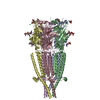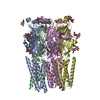[English] 日本語
 Yorodumi
Yorodumi- PDB-8blb: Human serotonin 5-HT3A receptor in complex with vortioxetine (nan... -
+ Open data
Open data
- Basic information
Basic information
| Entry | Database: PDB / ID: 8blb | ||||||
|---|---|---|---|---|---|---|---|
| Title | Human serotonin 5-HT3A receptor in complex with vortioxetine (nanodiscs, ECD, active/distorted conformation) | ||||||
 Components Components | 5-hydroxytryptamine receptor 3A | ||||||
 Keywords Keywords |  MEMBRANE PROTEIN / Human pentameric ligand-gated ion channel / MEMBRANE PROTEIN / Human pentameric ligand-gated ion channel /  Human serotonin receptor Human serotonin receptor | ||||||
| Function / homology |  Function and homology information Function and homology informationNeurotransmitter receptors and postsynaptic signal transmission / serotonin-gated monoatomic cation channel activity / serotonin-activated cation-selective channel complex / serotonin receptor signaling pathway /  serotonin binding / acetylcholine-gated monoatomic cation-selective channel activity / inorganic cation transmembrane transport / serotonin binding / acetylcholine-gated monoatomic cation-selective channel activity / inorganic cation transmembrane transport /  cleavage furrow / ligand-gated monoatomic ion channel activity involved in regulation of presynaptic membrane potential / cleavage furrow / ligand-gated monoatomic ion channel activity involved in regulation of presynaptic membrane potential /  postsynaptic membrane ...Neurotransmitter receptors and postsynaptic signal transmission / serotonin-gated monoatomic cation channel activity / serotonin-activated cation-selective channel complex / serotonin receptor signaling pathway / postsynaptic membrane ...Neurotransmitter receptors and postsynaptic signal transmission / serotonin-gated monoatomic cation channel activity / serotonin-activated cation-selective channel complex / serotonin receptor signaling pathway /  serotonin binding / acetylcholine-gated monoatomic cation-selective channel activity / inorganic cation transmembrane transport / serotonin binding / acetylcholine-gated monoatomic cation-selective channel activity / inorganic cation transmembrane transport /  cleavage furrow / ligand-gated monoatomic ion channel activity involved in regulation of presynaptic membrane potential / cleavage furrow / ligand-gated monoatomic ion channel activity involved in regulation of presynaptic membrane potential /  postsynaptic membrane / neuron projection / postsynaptic membrane / neuron projection /  synapse / identical protein binding / synapse / identical protein binding /  plasma membrane plasma membraneSimilarity search - Function | ||||||
| Biological species |   Homo sapiens (human) Homo sapiens (human) | ||||||
| Method |  ELECTRON MICROSCOPY / ELECTRON MICROSCOPY /  single particle reconstruction / single particle reconstruction /  cryo EM / Resolution: 3.3 Å cryo EM / Resolution: 3.3 Å | ||||||
 Authors Authors | Lopez-Sanchez, U. / Nury, H. | ||||||
| Funding support | European Union, 1items
| ||||||
 Citation Citation |  Journal: Nat Struct Mol Biol / Year: 2024 Journal: Nat Struct Mol Biol / Year: 2024Title: Structural determinants for activity of the antidepressant vortioxetine at human and rodent 5-HT receptors. Authors: Uriel López-Sánchez / Lachlan Jake Munro / Lucy Kate Ladefoged / Anders Juel Pedersen / Christian Colding Brun / Signe Meisner Lyngby / Delphine Baud / Céline Juillan-Binard / Miriam ...Authors: Uriel López-Sánchez / Lachlan Jake Munro / Lucy Kate Ladefoged / Anders Juel Pedersen / Christian Colding Brun / Signe Meisner Lyngby / Delphine Baud / Céline Juillan-Binard / Miriam Grønborg Pedersen / Sarah C R Lummis / Benny Bang-Andersen / Birgit Schiøtt / Christophe Chipot / Guy Schoehn / Jacques Neyton / Francois Dehez / Hugues Nury / Anders S Kristensen /     Abstract: Vortioxetine (VTX) is a recently approved antidepressant that targets a variety of serotonin receptors. Here, we investigate the drug's molecular mechanism of operation at the serotonin 5-HT receptor ...Vortioxetine (VTX) is a recently approved antidepressant that targets a variety of serotonin receptors. Here, we investigate the drug's molecular mechanism of operation at the serotonin 5-HT receptor (5-HTR), which features two properties: VTX acts differently on rodent and human 5-HTR, and VTX appears to suppress any subsequent response to agonists. Using a combination of cryo-EM, electrophysiology, voltage-clamp fluorometry and molecular dynamics, we show that VTX stabilizes a resting inhibited state of the mouse 5-HTR and an agonist-bound-like state of human 5-HTR, in line with the functional profile of the drug. We report four human 5-HTR structures and show that the human receptor transmembrane domain is intrinsically fragile. We also explain the lack of recovery after VTX administration via a membrane partition mechanism. | ||||||
| History |
|
- Structure visualization
Structure visualization
| Structure viewer | Molecule:  Molmil Molmil Jmol/JSmol Jmol/JSmol |
|---|
- Downloads & links
Downloads & links
- Download
Download
| PDBx/mmCIF format |  8blb.cif.gz 8blb.cif.gz | 252.8 KB | Display |  PDBx/mmCIF format PDBx/mmCIF format |
|---|---|---|---|---|
| PDB format |  pdb8blb.ent.gz pdb8blb.ent.gz | 198.1 KB | Display |  PDB format PDB format |
| PDBx/mmJSON format |  8blb.json.gz 8blb.json.gz | Tree view |  PDBx/mmJSON format PDBx/mmJSON format | |
| Others |  Other downloads Other downloads |
-Validation report
| Arichive directory |  https://data.pdbj.org/pub/pdb/validation_reports/bl/8blb https://data.pdbj.org/pub/pdb/validation_reports/bl/8blb ftp://data.pdbj.org/pub/pdb/validation_reports/bl/8blb ftp://data.pdbj.org/pub/pdb/validation_reports/bl/8blb | HTTPS FTP |
|---|
-Related structure data
| Related structure data |  16105MC  8aw2C  8axdC  8bl8C  8blaC M: map data used to model this data C: citing same article ( |
|---|---|
| Similar structure data | Similarity search - Function & homology  F&H Search F&H Search |
- Links
Links
- Assembly
Assembly
| Deposited unit | 
|
|---|---|
| 1 |
|
- Components
Components
| #1: Protein | Mass: 52172.324 Da / Num. of mol.: 5 Source method: isolated from a genetically manipulated source Source: (gene. exp.)   Homo sapiens (human) / Gene: HTR3A, 5HT3R, HTR3 / Production host: Homo sapiens (human) / Gene: HTR3A, 5HT3R, HTR3 / Production host:   Homo sapiens (human) / References: UniProt: P46098 Homo sapiens (human) / References: UniProt: P46098#2: Polysaccharide | 2-acetamido-2-deoxy-beta-D-glucopyranose-(1-4)-2-acetamido-2-deoxy-beta-D-glucopyranose  / Mass: 424.401 Da / Num. of mol.: 10 / Mass: 424.401 Da / Num. of mol.: 10Source method: isolated from a genetically manipulated source #3: Sugar | ChemComp-NAG /  N-Acetylglucosamine N-Acetylglucosamine#4: Chemical | ChemComp-VTX / Mass: 298.446 Da / Num. of mol.: 5 / Source method: obtained synthetically / Formula: C18H22N2S / Feature type: SUBJECT OF INVESTIGATION Has ligand of interest | Y | |
|---|
-Experimental details
-Experiment
| Experiment | Method:  ELECTRON MICROSCOPY ELECTRON MICROSCOPY |
|---|---|
| EM experiment | Aggregation state: PARTICLE / 3D reconstruction method:  single particle reconstruction single particle reconstruction |
- Sample preparation
Sample preparation
| Component | Name: Human 5HT3A receptor in complex with vortioxetine / Type: COMPLEX Details: (nanodiscs, ECD only, active/distorted conformation) Entity ID: #1 / Source: RECOMBINANT |
|---|---|
| Molecular weight | Experimental value: NO |
| Source (natural) | Organism:   Homo sapiens (human) Homo sapiens (human) |
| Source (recombinant) | Organism:   Homo sapiens (human) Homo sapiens (human) |
| Buffer solution | pH: 7.4 |
| Specimen | Conc.: 6 mg/ml / Embedding applied: NO / Shadowing applied: NO / Staining applied : NO / Vitrification applied : NO / Vitrification applied : YES : YES |
Vitrification | Instrument: FEI VITROBOT MARK IV / Cryogen name: ETHANE / Humidity: 100 % / Chamber temperature: 279 K |
- Electron microscopy imaging
Electron microscopy imaging
| Microscopy | Model: TFS GLACIOS |
|---|---|
| Electron gun | Electron source : :  FIELD EMISSION GUN / Accelerating voltage: 200 kV / Illumination mode: FLOOD BEAM FIELD EMISSION GUN / Accelerating voltage: 200 kV / Illumination mode: FLOOD BEAM |
| Electron lens | Mode: BRIGHT FIELD Bright-field microscopy / Nominal defocus max: 2300 nm / Nominal defocus min: 700 nm Bright-field microscopy / Nominal defocus max: 2300 nm / Nominal defocus min: 700 nm |
| Image recording | Electron dose: 40 e/Å2 / Detector mode: COUNTING / Film or detector model: GATAN K2 SUMMIT (4k x 4k) |
- Processing
Processing
| Software | Name: PHENIX / Version: 1.20.1_4487: / Classification: refinement | ||||||||||||||||||||||||
|---|---|---|---|---|---|---|---|---|---|---|---|---|---|---|---|---|---|---|---|---|---|---|---|---|---|
CTF correction | Type: PHASE FLIPPING AND AMPLITUDE CORRECTION | ||||||||||||||||||||||||
3D reconstruction | Resolution: 3.3 Å / Resolution method: FSC 0.143 CUT-OFF / Num. of particles: 31911 / Symmetry type: POINT | ||||||||||||||||||||||||
| Refine LS restraints |
|
 Movie
Movie Controller
Controller






 PDBj
PDBj



